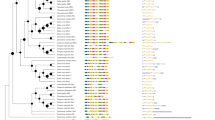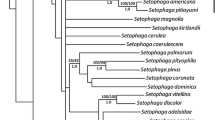Summary
Using α- and β-hemoglobin sequences, we made a maximum likelihood inference as to the phylogenetic relationship among carnivores, including the two pandas, giant and lesser. Molecular phylogenetic studies up to 1985 had consistently indicated that the giant panda is more closely related to the bear than to the lesser panda. In 1986, however, a contradictory tree was constructed, using hemoglobins and so on, in which the two pandas link together (Tagle et al. 1986). In contrast to that tree, our conclusion supports the close relationship between bear and giant panda. The surface impression of a close relationship between the two pandas drawn from pairwise amino acid differences is explained by a rapid rate of hemoglobin evolution in the bear compared to that in the two pandas.
Similar content being viewed by others
References
Adachi J, Hasegawa M (1992a) Computer Science Monographs, No 27, MOLPHY: Programs for molecular phylogenetics I—PROTML: Maximum likelihood inference of protein phylogeny. Institute of Statistical Mathematics, Tokyo
Adachi J, Hasegawa M (1992b) Amino acid substitution of proteins coded for in mitochondrial DNA during mammalian evolution. Jap J Genet 67:187–197
Adachi J, Hasegawa M (1992b) Amino acid substitution of proteins coded for in mitochondrial DNA during mammalian evolution. Jap J Genet 67:187–197
Brimhall B, Stangland K, Jones RT, Becker RR, Bailey TJ (1978) Amino acid sequence of the hemoglobin of raccoon (Procyon lotor). Hemoglobin 2:351–370
Czelusniak J, Goodman M, Moncrief ND, Kehoe SM (1990) Maximum parsimony approach to construction of evolutionary trees from aligned homologous sequences. Methods Enzymol 183:601–615
Czelusniak J, Goodman M, Koop BF, Tagle DA, Shoshani J, Braunitzer G, Kleinschmidt TK, de Jong WW, Matsuda G (1991) Perspectives from amino acid and nucleotide sequences on cladistic relationships among higher taxa of eutheria. In: Genoways HH (ed) Current mammalogy vol 2. Plenum, New York, pp 545–572
Dayhoff MO, Schwartz RM, Orcutt BC (1978) A model of evolutionary change in proteins. In: Dayhoff MO (ed) Atlas of protein sequence and structure, vol 5, suppl 3. National Biomedical Research Foundation, Washington DC, pp 345–352
Felsenstein J (1978) Cases in which parsimony and compatibility methods will be positively misleading. Syst Zool 27:401–410
Felsenstein J (1981) Evolutionary trees from DNA sequences: a maximum likelihood approach. J Mol Evol 17:368–376
Hasegawa M, Kishino H, Hayasaka K, Horai S (1990) Mitochondrial DNA evolution in primates: transition rate has been extremely low in lemur. J Mol Evol 31:113–121
Hasegawa M, Kishino H, Saitou N (1991) On the maximum likelihood method in molecular phylogenetics. J Mol Evol 32: 443–445
Hasegawa M, Cao Y, Adachi J, Yano T (1992) Rodent polyphyly? Nature 355:595
Hasegawa M, Hashimoto T, Adachi J, Iwabe N, Miyata T (1993) Early divergences in the evolution of eukaryotes: ancient divergence of Entamoeba that lacks mitochondria revealed by protein sequence data. J Mol Evol, in press
Hofmann O, Braunitzer G (1987) The primary structure of the hemoglobin of spectacled bear (Tremarctos ornatus, Carnivora). Biol Chem Hoppe-Seyler 368:949–954
Hofmann O, Schreitmuller T, Braunitzer G (1986) Die primarstruktur derhämoglobine von eisbär (Ursus maritimus, Carnivora) and kragenbär (Ursus tibetanus, Carnivora). Biol Chem Hoppe-Seyler 367:53–59
Hombrados I, Ducastaing S, Iron A, Neuzil E, Debuire B, Han K (1976) Primary structure of the β-chain of badger hemoglobin. Biochim Biophys Acta 427:107–118
Hombrados I, Neuzil E, Debuire B, Han K (1978) The amino acid sequence of the a chain of badger (Meles meles) haemoglobin. Biochim Biophys Acta 535:1–10
Kimura M (1983) In: The neutral theory of molecular evolution. Cambridge Univ Press, Cambridge, pp 55–97
Kishino H, Hasegawa M (1989) Evaluation of the maximum likelihood estimate of the evolutionary tree topologies from DNA sequence data, and the branching order in Hominoidea. J Mol Evol 29:170–179
Kishino H, Hasegawa M (1990) Converting distance to time: an application to human evolution. Methods Enzymol 183:550–570
Kishino H, Miyata T, Hasegawa M (1990) Maximum likelihood inference of protein phylogeny and the origin of chloroplasts. J Mol Evol 30:151–160
Lin H, Kleinschmidt T, Braunitzer G (1988) Carnivora: The primary structure of the common otter (Lutra lutra, Mustelidae) hemoglobin. Biol Chem Hoppe-Seyler 369:349–355
Mayr E (1986) Uncertainty in science: is the giant panda a bear or a raccoon? Nature 323:769–771
O'Brien SJ, Nash WG, Wildt DE, Bush ME, Benveniste RE (1985) A molecular solution to the riddle of the giant panda's phylogeny. Nature 317:140–144
Rodewald K, Braunitzer G (1988) Carnivora: Primary structure of the hemoglobins from ratel (Mellivora capensis). Biol Chem Hoppe-Seyler 369: 1137–1142
Saitou N, Nei M (1987) The neighbor joining method: A new method for reconstructing phylogenetic trees. Mol Biol Evol 4:406–425
Sakamoto Y, Ishiguro M, Kitagawa G (1986) Akaike information criterion statistics. D Reidel Publ Comp, Dordrecht
Sarich VM (1973) The giant panda is a bear. Nature 245:218–220
Tagle DA, Miyamoto MM, Goodman M, Hofmann O, Braunitzer G, Göltenboth R (1986) Hemoglobin of pandas: phylogenetic relationships of carnivores as ascertained with protein sequence data. Naturwissenschaften 73:512–514
Watanabe B, Maita T, Matsuda G, Goodman M, Johnson ML (1986) Amino-acid sequence of the a and R chains of adult hemoglobin of the harbor seal, Phoca vitulina. Biol Chem Hoppe-Seyler 367:1251–1258
Zhang Y, Shi L (1991) Riddle of the giant panda. Nature 352:573
Author information
Authors and Affiliations
Additional information
Offprint requests to: T. Hashimoto
Rights and permissions
About this article
Cite this article
Hashimoto, T., Otaka, E., Adachi, J. et al. The giant panda is closer to a bear, judged by α- and β-hemoglobin sequences. J Mol Evol 36, 282–289 (1993). https://doi.org/10.1007/BF00160484
Received:
Revised:
Issue Date:
DOI: https://doi.org/10.1007/BF00160484




